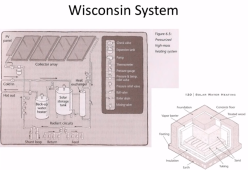callmeburton
New Member
- Joined
- Mar 4, 2022
- Messages
- 240
Seeking resources on how best to do this, rules to follow, what to expect, etc. Like how many panels to put in a string, considerations for types of glycol and its ratings, considerations for what to do when you have stored all you can store / use, suggested materials, etc. There are a ton of PV resources out there but not too many detailed SHW resources so far as I can tell.
Details:
We have a about 150-170 tubes if I recall, 5 complete panels and half of another if I recall ... Originally these were used to heat someone's house and we plan on using them for Domestic Hot Water (DHW) + hydronic radiant heating (HRH). Based on my WUFI calculations we should only need 2.5-3 cord of wood to pull this off but I will believe it when I see it. We are not going to mount these on the roof because we get a lot of snow so I was thinking of going with a ground mount. Whole south side of the building is glazed and depending on the time of year it is also shaded.
I found exactly one website, which I wont link because they sell stuff, who had an example of how to do this. They were using coper from the array back to the structure with insulation / sand bedding / and frost protected depths.
We install several extra 4" pipes going out the south side of our building along with our 24" earth tubes so getting the plumbing back into the house from the south side of our property likely wont be an issue. The earth tubes have insulation on top of them so the ground temperature can penetrate the tube but not the frost.
For excess storage originally I was going to install at minimal a 1k gal insulated unpressurized tank to help us pull through dark days / weeks ... the largest tank I can fit is something close to 9k but at that point it might be better to get a 1.5kgal indoor wood boiler and run the solar through that as we gain the backup of the wood as well. Wife would also like it if we can use this setup to heat up a hot tub, we did plan a space for one in our solarium space.
Thoughts? This likely won't even happen this year as I am still building the house so we have time to think about it. Depending what is suggested though we might have to change some of our plumbing plans outside the building with the external pipes we have in excess.
Details:
We have a about 150-170 tubes if I recall, 5 complete panels and half of another if I recall ... Originally these were used to heat someone's house and we plan on using them for Domestic Hot Water (DHW) + hydronic radiant heating (HRH). Based on my WUFI calculations we should only need 2.5-3 cord of wood to pull this off but I will believe it when I see it. We are not going to mount these on the roof because we get a lot of snow so I was thinking of going with a ground mount. Whole south side of the building is glazed and depending on the time of year it is also shaded.
I found exactly one website, which I wont link because they sell stuff, who had an example of how to do this. They were using coper from the array back to the structure with insulation / sand bedding / and frost protected depths.
We install several extra 4" pipes going out the south side of our building along with our 24" earth tubes so getting the plumbing back into the house from the south side of our property likely wont be an issue. The earth tubes have insulation on top of them so the ground temperature can penetrate the tube but not the frost.
For excess storage originally I was going to install at minimal a 1k gal insulated unpressurized tank to help us pull through dark days / weeks ... the largest tank I can fit is something close to 9k but at that point it might be better to get a 1.5kgal indoor wood boiler and run the solar through that as we gain the backup of the wood as well. Wife would also like it if we can use this setup to heat up a hot tub, we did plan a space for one in our solarium space.
Thoughts? This likely won't even happen this year as I am still building the house so we have time to think about it. Depending what is suggested though we might have to change some of our plumbing plans outside the building with the external pipes we have in excess.



